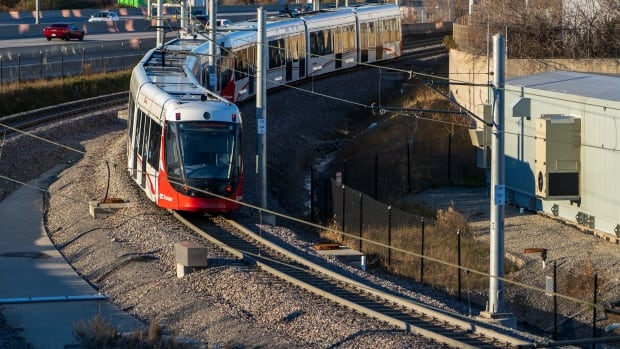Watch Friday’s hearing here:
Train-maker Alstom created a vehicle for the Confederation Line that did not yet exist and that was “pushing the limits” of what a light rail car can do, the Ottawa LRT public inquiry heard Thursday.
The City of Ottawa wanted to move 24,000 passengers an hour in each direction, which was “exceptional” and more in line with subways as opposed to light rail, said Yves Declercq, the light rail product director for Alstom who testified in French on Thursday.
Subways are more “robust” than light rail trams, Declercq explained, adding the company even replaced the tram engine with one it used on New York’s subways.
“We were pushing the limit,” said Declercq, referring to the trains the company ended up designing to run on the Confederation Line. “And that does explain, in part, the problems that were incurred later. So we were at the limits of the concept and came across new problems that we don’t usually come across.”
The Alstom executive also made it clear the city knew as early as the summer of 2012 that the light rail train it was asking for didn’t already exist.
WATCH | Alstom says new LRT train was ‘pushing the limit’ of what a light-rail vehicle could do:
Yves Declercq, the light rail product director for Alstom, told the LRT inquiry Thursday that the Citadis Spirit, developed for Ottawa’s Confederation Line, was “pushing the limit” of what light rail could do, leading to issues when the system opened.
Short-notice proposal
Alstom came to be a subcontractor of Rideau Transit Group in an unusual way, Declercq told the commission.
It had already tried to bid on the Confederation Line with a different consortium but didn’t make the cut. That request for qualifications in 2011 described how Ottawa wanted to carry 12,000 passengers per hour per direction on opening day, with the option for double that ridership sometime in the 2030s or beyond.
Alstom was surprised when Rideau Transit Group (RTG) came calling in June 2012, asking it to propose a train for Ottawa after RTG’s first choice, by Spanish company CAF, was disqualified by the city.
It was “very rare” for a company to rejoin a bidding process after having been eliminated, Declercq explained to the commission.
Within mere weeks, Alstom was in a meeting with RTG and the city — the one and only meeting Alstom attended with the city before the contract was signed — describing the train it could offer.
The Alstom Citadis Spirit that operates on the Confederation Line is based on the existing Citadis Dualis model used in places like Nantes, France. The Spirit model developed for the North American market is longer, had to be adapted to U.S. electric rail standards (as opposed to European standards), and needed to be adapted for Canadian winters because the Dualis only operated at temperatures as low as -25 C.
Alstom told the city in that summer 2012 presentation that it was confident it could adapt its existing vehicle — for example, it had winter technology on other train models used in Sweden and Russia — but that it was transparent the vehicle the city wanted did not exist.
“We never said the train was developed and ready to go,” said Declercq. “I think the presentation was very clear on what was existing, how we would develop the model and how it differs from existing models.”
An external lawyer for the City of Ottawa, Jesse Gardner, later pointed out Declercq didn’t state to the city that its requirements were at the edge of what a light rail vehicle could do.
Gardner then pressed Declercq about whether Alstom had ultimately provided vehicles that met the contract’s requirements, and Declercq agreed it had.
WATCH | LRT train manufacturer adapted vehicle for Ottawa light rail line, inquiry hears:
Yves Declercq, the light rail product director for Alstom, said the company was clear during a presentation in 2012 that the train Ottawa officials wanted for the new light rail line didn’t yet exist and would have to be developed for the project.
Alstom charges that Ottawa’s track is non-compliant
Those trains were manufactured in Ottawa, despite Alstom feeling the labour force lacked the skill.
Alstom had no other choice because the city required a 25 per cent Canadian content rule in order to get funding from upper levels of government, Declercq explained.
Given Canada didn’t have parts to sell, Alstom had to use Canadian labour.
Declercq testified there were other issues with how its trains came together. The computer control system for the trains automatically controls acceleration and deceleration, and was provided by a different company.

Then, there are the tracks themselves. Alstom’s position is that the track on which Ottawa’s light rail trains run is “non-compliant” and contributed to the derailment nearly a decade later, in August 2021, when a train axle broke.
Declercq said Alstom said it had seen such a problem on its Dualis trains before with wheel hubs, but the problem happened far faster in Ottawa than it had seen before.
The company has been investigating, and found other axles were being damaged. Alstom’s own experts believe the main cause is “fretting,” or the way the rail was putting stress and wear on the wheels.
RTG does not agree with what it calls Alstom’s “preliminary conclusions,” which it said were completed without third party experts.
Hearings resume Friday with Antonio Estrada, who was RTG’s CEO from 2013 to 2018.





















Discussion about this post